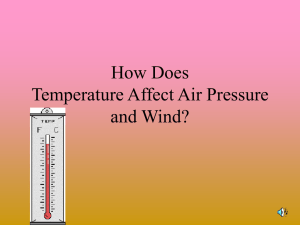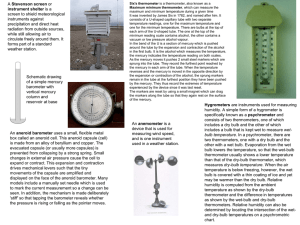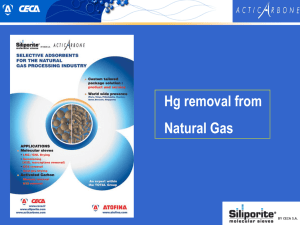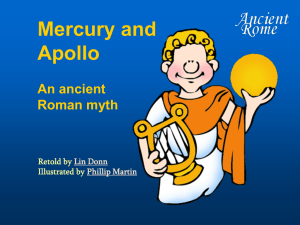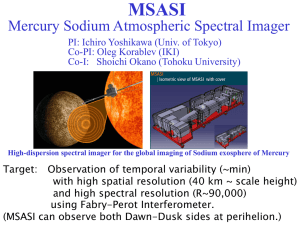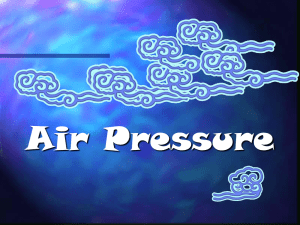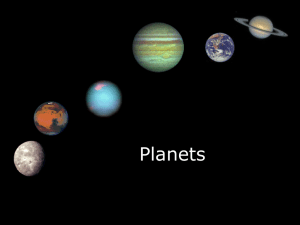Mercury: The planet that`s impossible to see
advertisement
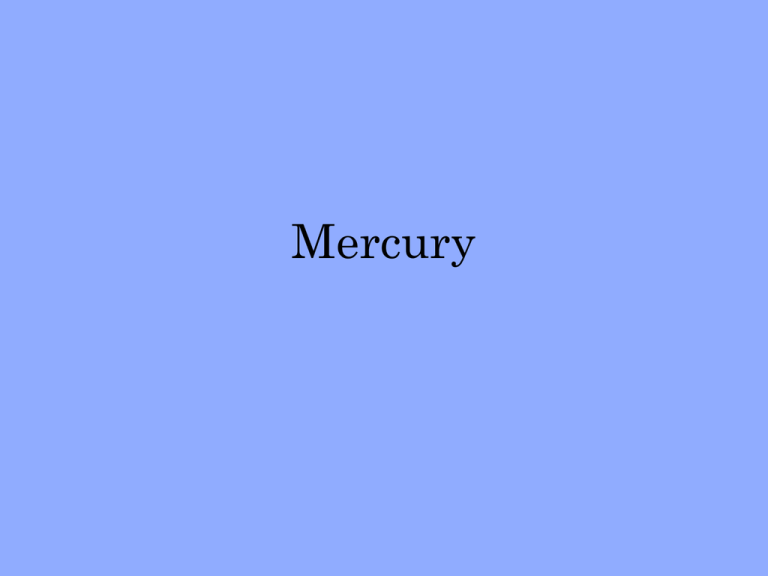
Mercury Mercury Mercury Mercury is always close to the sun! What is being shown here? The sun looks bigger from Mercury than from Earth Effective Temperature : An estimate of the surface temperature of a planet, based only on its distance from the sun Assumptions: Energy hitting surface of planet= Energy radiated by planet Planet has no atmosphere Planet absorbs all of the light that hits it Effective Temperature : An estimate of the surface temperature of a planet, based only on its distance from the sun Planet Eff. Temp. Mercury 350° F Venus 134° F Earth 44° F Mars -45° F Actual Surf Temps -333-746° F 800-900° F 26-80° F -190- -10° F What’s going on? Why is Mercury not uniformly hot? Does Mercury have seasons like on Earth? Winter on Earth Summer on Earth Any time on Earth! One of these is a circle. One is Earth’s (elliptical) orbit. Does Mercury have seasons like on Earth? Does Mercury have seasons like on Earth? Mercury’s orbital path around the sun Mercury’s orbit has a higher eccentricity. Perihelion=closest approach Aphelion=farthest distance What is being shown here? The Sun from Mercury at perihelion and aphelion Mercury has a 2:3 resonance between its spin and orbital periods. So every time Mercury goes ~2/3 of the way around the sun, it has rotated once. For Earth: Orbital period:? Rotation period: ? Mercury has a 2:3 resonance between its spin and orbital periods. So every time Mercury goes ~2/3 of the way around the sun, it has rotated once. For Earth: Orbital period: 365 days Rotation period: 1 day Mercury has a 2:3 resonance between its spin and orbital periods. So every time Mercury goes ~2/3 of the way around the sun, it has rotated once. For Earth: For Mercury: Orbital period: 365 days Orbital period: 88 Earth days Rotation period: 1 day Rotation period: 59 Earth days Mercury has a 2:3 resonance between its spin and orbital periods. So every time Mercury goes ~2/3 of the way around the sun, it has rotated once. For Earth: For Mercury: Orbital period: 365 days Orbital period: 88 Earth days Rotation period: 1 day Rotation period: 59 Earth days Orbital period: 1 1/2 Mercury days Rotation period: 1 Mercury day Class Action: Terrestrial planets: Length of Mercury night Messenger Animation: A day on Mercury Also, the poles on Mercury never see sunlight! Images of north polar region colored by amount of sunlight received Summary of Mercury’s orbital characteristics: -Mercury is much closer to the sun than Earth -Mercury’s tilt is very low, so it does not have seasons caused by the tilt -Its rotation period is almost equal to its orbital period, so there are long days, long nights -Mercury’s orbit is eccentric so the sun changes size throughout the year -Both the long days/long nights and eccentricity cause extreme temperature swings -The poles of Mercury never see sunlight and can be very cold, so different parts of the surface of Mercury can be different temperatures Now let’s talk about Mercury’s interior and its geology Density is a measure of compactness. Density is a measure of compactness. The density of rock is ~2.5 g/cm3. The density of iron is ~8 g/cm3. The density of terrestrial planets is ~5 g/cm3. Given this information, what are terrestrial planets most likely made of? (A) Rock rock (B) Iron (C) Both rock and iron Iron meteorit Mercury is small, and composed largely of iron. 1800 km 2400 km Mercury Earth How did Mercury get this dense? How did Mercury get this dense? Two ideas: Heat from the early sun vaporized many of the rocky materials when Mercury was forming. A giant impact stripped off the original crust and mantle. Really, no one knows. How might you test these hypotheses? Does Mercury have an atmosphere? Sort of. Hydrogen, Helium, Oxygen, Sodium, Potassium and Calcium have been detected. But atmospheric pressures are very low Why is this? What is Mercury’s surface like? Mariner 10 (c. 1974) was the first and only spacecraft to visit Mercury before 2008. Mariner 10 was a flyby mission (it did not orbit the planet). Why do you think this is? Mercury’s main geological features: • Heavily cratered terrain • Intercrater plains • The Caloris Basin • Antipodal terrain • Scarps Heavily cratered highlands and intercrater plains What caused the intercrater plains? The Caloris Basin Caloris Antipode Scarps and Ridges These scarps are fault scarps. What caused them? Here is a fault scarp on the Earth (in Idaho) http://skywalker.cochise.edu/wellerr/pglnx/chapter17x.htm Ice on Mercury?? Messenger mission to Mercury. Launched in 2004. Now orbiting Mercury! • • • • • • Why is Mercury so dense? What is the geologic history of Mercury? What is the structure of Mercury's core? What is the nature of Mercury's magnetic field? What are the unusual materials at Mercury's poles? What volatiles are important at Mercury? The Caloris Basin The Caloris Basin (a false color image) The Caloris Antipode Strange “blue hollows” on Mercury represent neverbefore-seen minerals Images of north polar region shows very reflective materials in shadowed regions (like craters) Images of north polar region shows very reflective materials in shadowed regions (like craters) The highest-resolution radar image of Mercury's south polar region made from the Arecibo Observatory (Harmon et al., Icarus, 211, 37-50, 2011) is shown in white on MESSENGER orbital images colorized by the faction of time the surface is illuminated. (Text: Marc Boucher) Crater counting lecture tutorial Why did Mercury end up in this state? Planets like to be in ‘synchronous’ rotation because of tides. The closer a planet is to the sun, the stronger the tides. in synchronous rotation dir. of orbital motion Forces rotating faster than synchronous dir. of orbital motion Forces rotating slower than synchronous dir. of orbital motion Why did Mercury end up in this state? Mercury’s orbit is eccentric. During which part of an orbit is the tidal force greatest? At this point of the orbit, does the planet move slower or faster than average? To keep its bulges aligned while near this point, will it need to rotate faster or slower? (For many years, scientists assumed Mercury was in synchronous rotation!)

